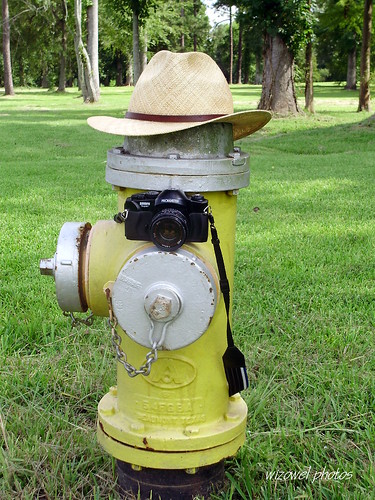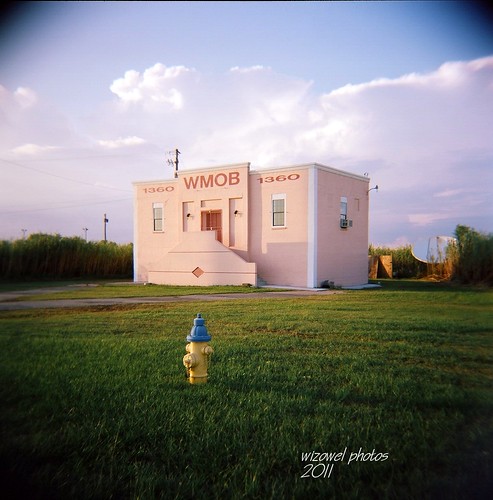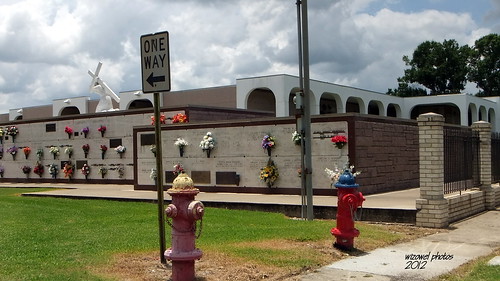Here's another hydrant from my collection.This one guards Holy Ghost Catholic Church in Hammond, La.
Fire hydrants are ubiquitous to the point of being generally invisible. I have made it my purpose to show that they are indeed everywhere and can be interesting subjects when taken in context.
Wednesday, July 25, 2012
Holy Ghost Hydrant
Tuesday, July 24, 2012
Monday, July 23, 2012
Fujifilm Discontinues Some Film Products
In an article on ephotozine.com today Gabriel Da Costa, product manager for professional film, was quoted as saying, “Due to decreasing demand globally we have to announce the withdrawal of some formats of Velvia 100F and Velvia 50. It is an unfortunate consequence of digital capture, that some of the slower selling silver-halide lines will drop off the radar. Fujifilm will continue to manufacture a wide range of film and the increasing support for our Choose Film group illustrates there is still a passion for film photography across the world.”
Well at least he committed to keep supporting film users albeit with a smaller stable of products. Here's the link if you want to read the whole article.
Fujifilm Fujichrome Velvia 100F 35mm, 120, 4x5 and 50 4x5, 8x10 Discontinued
Well at least he committed to keep supporting film users albeit with a smaller stable of products. Here's the link if you want to read the whole article.
Fujifilm Fujichrome Velvia 100F 35mm, 120, 4x5 and 50 4x5, 8x10 Discontinued
Dressing up!
The jingle goes, "Sometimes you feel like a nut..." and then sometimes you just feel like dressing up a fire hydrant!
Tuesday, July 17, 2012
Silent Sentinel
In the midst of this fast food haven a lone fire hydrant stands in the flowers keeping watch against the mayhem.
Monday, July 16, 2012
See Rock City (Trail)
I'm still playing with Flickr. Here's my second upload, an oldie but goodie from my fire hydrant collection. Could this be a trend?
Thursday, July 12, 2012
Wednesday, July 11, 2012
What’s a Flickr?
One
of the great things about living on the Gulf Coast is Magnolia’s. Here’s a shot
taken with the Nikon P300 on auto at f5.5, 1/800 and ISO 160 for your viewing
pleasure.
I
am not ignorant of social media. After
all, I did “My Space” years ago and I’ve had a Facebook account now for almost
as long. So I finally checked out Flickr. I kept hearing about it and wondering
what it was all about. Turns out it’s kind of like Facebook for photographers.
You don’t have to write or say anything. You just upload pictures and everyone
gets to look at each other’s work. Of course you can comment on the photos,
yours and others’ so it’s not totally wordless but if you would rather shoot &
look at pictures than write or read then Flickr is for you.
I
actually set up the account months ago but just went there to look at photos,
one of my favorite things to do. In fact I try not to do it unless I have time
to spare because I get hooked and end up spending hours looking at all the
pictures.
Every time I logged on it would remind me that I hadn’t
set up my profile yet and that I had not uploaded any pictures either so this
week I finally did both. I uploaded one picture. Now it keeps reminding me that
I have no Flickr friends so I guess now I will have to go figure out how to “connect”
with other folks. So if you are already profiled, uploaded & connected on
Flickr keep an eye out for me. I got some catching up to do but I’m coming on
strong!
Tuesday, July 10, 2012
Vindication!
Here’s another shot taken with the new Fujifilm Fine Pix 3D
W3 on full auto mode at the Musee Conti Wax Museum in New Orleans. This one at F3.7,
1/26 & ISO 800 shows the life sized wax figure of Louis Armstrong framed by
Jazz Fest posters from 1996 and 2001 as well as other memorabilia and again. This is a great shot but
you should see the 3-D version of this picture!
On
June 13th, I posted my latest thoughts on why I still don’t like
digital cameras, especially full featured DSLR’s. Well I just discovered Ken Rockwell’s “Is
Slow Good, Or is Slow Bad,” blog post from June 26th where he not
only agrees with what I said but says it even better than I did.
Ken
says, “It's horrible when marketing departments have loaded appliances
that parade as "cameras" with so many junk features that few of us
can master them well enough to take a picture.”
Wow Ken, tell us how you really feel! I agree whole
heartedly and have been searching for a DSLR that works just like my SLR’s
except with an electronic sensor instead of film – no luck so far.
In his post Ken seems to be struggling with his new Nikon
D800 and has the following to say about this otherwise fine camera.
“On consumer electronics products like the D800,
we now have 845 different options and menu items, which provide a total of over
5,439,486,960,532 different combinations of settings — of which only one
is correct.”
I’m not sure about the accuracy of his math but again, I
agree whole heartedly with his conclusion.
I highly recommend you check out his excellent blog at http://www.kenrockwell.com/ for an
incredible amount of helpful information on both digital cameras and “real”
cameras as Ken calls film cameras. Ken has only one flaw as I see it. He thinks
the only two camera systems worth messing with are Nikon and Canon and his
prejudices show through in his opinionated commentaries. Of course I am equally
prejudiced in my preference for Pentax, go figure!
In any case it’s good to know that I am not the only one who
thinks that these new generation digital cameras are more than a little
overwhelming. Other than clinging to
film we really have only two other options. Either we spend countless hours
poring over manuals until we figure it all out and then constantly “fiddle”
with menus before during and after our photo shoots, or as I fear more and more
folks are doing, just put the thing on “Auto” and hope for the best.
Monday, July 9, 2012
Capitalism Strikes Again!
Here’s a shot taken with my new Fujifilm Fine Pix 3D W3 on
full auto mode at f3.7, 1/110 and ISO 200. One of the few complaints I have
about this little specialty camera is the lens just isn’t fast enough or wide
enough for my needs. It is great for 3-D of course (you should see this shot in
“Real 3-D”) and decent for a compact 2-D shooter even, but for an all-around
general purpose compact it just can’t compare to the Nikon P-300.
Now some of you may have noticed the “clickable” display
adds on the blog these days. This is an experiment I’ve wanted to try for a
while. I’ve wondered if I am doing this blog thing correctly. By setting the
blog up for adds I accomplished two things. First, the blog content was run through an apparently
thorough analysis to see if there were any problems with regard to copyright
infringement etc. Second, I get to find out if it is possible to make money
this way.
The result of the first analysis is in of course and
everything is fine. That’s why you’re seeing the adds now. The results for the
second item won’t be known for a few more weeks. I figure it will take at least
that long to see what happens. I am impressed so far with how well the
algorithm seems to be matching the adds with the blog’s content. Presumably
you’re reading the blog because you’re interested in photography so they should
be advertising photography related products and not trying to sell you a
bicycle!
So if you see anything you’re interested click on one or two
of the links so I can see what happens. I had to agree not to click on them
myself as part of the deal so unless you guys do it I may never find out or
make any money.
Also, if you find the adds annoying or distracting let me
know and I will “pull the plug on them,” unless of course you guys make me
wealthy with your fervent clicking.
Wednesday, July 4, 2012
3-D Viewers!
In the past few weeks I have determined that taking 3-D
photos is actually pretty easy. The required post processing is a bit tedious
and inconvenient but not terrible either. The real challenge comes in the
viewing!
For the 50% of the population that can “freeview” 3-D images
comfortably it is not generally a problem but for everyone else some device must
be used to “see” 3-D.
I will discount 3-D prints for the moment because I haven’t
seen any yet. I will eventually get to that subject. There are only two sources
that I know of, Fujifilm and Snap3-D.com, in Canada and 3-D Snap just announced
that their last 3-D film printer is broken so their future in 3-D printing is
uncertain for now, at least from film. There was a hint on the web site notice
that they may be moving into the digital to 3-D print business soon. For now
however, let’s just set that discussion
aside.
There are of course some 3-D televisions and/or monitors.
Except for the 3.5” monitor on my new Fujufilm Fine Pix 3D W3 digital camera I
have no knowledge or experience with these either. I do believe however, that
the 7” monitor that Fujufilm sells as an accessory for their camera is probably
just as amazing as the 3.5” monitor on the camera since it uses the same
technology just with a bigger screen size. For only a couple hundred dollars I
feel pretty confident in recommending it as a good investment for 3-D
aficionados with the only reservation being of course that I have not actually
seen or used one yet. Whether their technology will translate into a big screen
monitor eventually remains to be seen.
I have not done an exhaustive study on the subject but all
other 3-D televisions or monitors would appear (to me at least) to be too
expensive and too experimental to seriously consider for now. In spite of
impressive displays there is just too little 3-D programming available to
justify the cost and they also require the use of special 3-D glasses which I
find objectionable. I already wear glasses so I would have to have
“prescription” 3-D glasses or wear glasses on top of glasses to benefit from
the technology. That is expense on top of expense and just too inconvenient for
my taste!
That leaves us to examine the assortment of 3-D viewers
available. I purchased the two of them shown above mainly so my family (who
don’t seem to have the “gift” of freeviewing as I do) can enjoy the fruit of my
3-D labors with me. These and a host of other 3-D products can be bought from
These are both Loreo viewers. Loreo is a name well known in
the 3-D world for many years. The larger viewer on the left is for viewing
images (stereo pairs) 10-15 inches wide. This is what you would expect to see
on for most computer screens with a full screen image. It has elastic ear
strings for hands-free viewing so you can operate the computer mouse &
keyboard to scroll through your images.
The smaller viewer on the right is for images 5-7 inches
wide. This can be used with computer
screen images if they are reduced to a partial screen view and it also works
well with standard size photographs that have been aligned and cropped into a
viewable stereo pair.
Both of these viewers do an excellent job. They are inexpensive,
made of cardboard with plastic lenses and are collapsible with sleeves for easy
flat storage. There are certainly more expensive viewers, more durable viewers,
even more beautiful viewers, but I doubt that they are functionally any better
than these.
If you are unable to freeview 3-D stereo images get yourself
an inexpensive Loreo viewer and enjoy.
I have been stuck on this 3-D topic for a few weeks now and
need to move onto other subjects but I will return to it from time to time.
Once I have some 3-D prints made (something I definitely plan to do soon) I
will let you know how that works out and I may eventually experiment with the anaglyph
images too (the ones that require the glasses to see) just to see if my low
opinion in that regard is valid or mere prejudice.
Tuesday, July 3, 2012
“Freeviewing” Tips
I the last few blog posts have posted some stereo pairs for you to see what they
look like and try to “freeview” them. Above is another pair for you. This is a
shot of my back yard that comes through great in 3-D.
I suppose a couple of “freeviewing” tips are in order for
those who want to really try to “see” the 3-D images. First of all you must get
the images to the right size. When you pull up the blog page the images are too
small. After you click on them they will generally be too big. You see it’s all
about distance & proportions.
If you are going to “freeview” the 3-D image the stereo
pairs must be about the same distance from the center of one picture to the
center of the other picture as the distance between your eyes. Now this varies
a little from person to person but averages between 65 and 75 millimeters, or
about 2 ½” to 2 ¾”.
What you must do is set your browser window to partial (not
full) screen view and play with it a little until the pictures are the right
distance apart. Then you just stare at the middle and after a few moments your
brain will make the adjustment and then it suddenly appears in 3-D!
You may also have to vary your distance from the screen a
little and work at it at first to “train” your eyes and brain but eventually if
you are one of the 50% that can “freeview” you will quickly & easily make
the proper adjustments and “see” almost instantly.
Subscribe to:
Posts (Atom)











